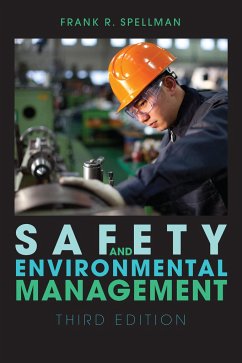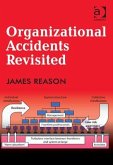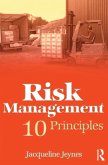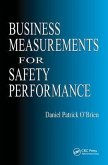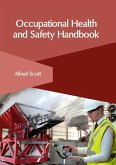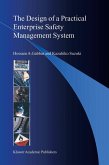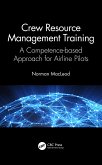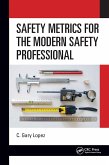Frank R Spellman
Safety and Environmental Management
Frank R Spellman
Safety and Environmental Management
- Gebundenes Buch
- Merkliste
- Auf die Merkliste
- Bewerten Bewerten
- Teilen
- Produkt teilen
- Produkterinnerung
- Produkterinnerung
What is required to make a workplace safe for employees and legally compliant with the Occupation Safety and Health Administration's regulations? Building on the success of the first two editions of Safety and Environmental Management, this updated and expanded third edition discusses the elements that should be included in any organization's safety plan, including sample plans to help guide managers in creating safety protocols for their own companies.
Andere Kunden interessierten sich auch für
![Organizational Accidents Revisited Organizational Accidents Revisited]() James ReasonOrganizational Accidents Revisited206,99 €
James ReasonOrganizational Accidents Revisited206,99 €![Risk Management: 10 Principles Risk Management: 10 Principles]() Jacqueline JeynesRisk Management: 10 Principles180,99 €
Jacqueline JeynesRisk Management: 10 Principles180,99 €![Business Measurements for Safety Performance Business Measurements for Safety Performance]() Daniel Patrick O'BrienBusiness Measurements for Safety Performance73,99 €
Daniel Patrick O'BrienBusiness Measurements for Safety Performance73,99 €![Occupational Health and Safety Handbook Occupational Health and Safety Handbook]() Occupational Health and Safety Handbook152,99 €
Occupational Health and Safety Handbook152,99 €![The Design of a Practical Enterprise Safety Management System The Design of a Practical Enterprise Safety Management System]() Hossam A. GabbarThe Design of a Practical Enterprise Safety Management System126,99 €
Hossam A. GabbarThe Design of a Practical Enterprise Safety Management System126,99 €![Crew Resource Management Training Crew Resource Management Training]() Norman MacleodCrew Resource Management Training183,99 €
Norman MacleodCrew Resource Management Training183,99 €![Safety Metrics for the Modern Safety Professional Safety Metrics for the Modern Safety Professional]() C Gary LopezSafety Metrics for the Modern Safety Professional142,99 €
C Gary LopezSafety Metrics for the Modern Safety Professional142,99 €-
-
-
What is required to make a workplace safe for employees and legally compliant with the Occupation Safety and Health Administration's regulations? Building on the success of the first two editions of Safety and Environmental Management, this updated and expanded third edition discusses the elements that should be included in any organization's safety plan, including sample plans to help guide managers in creating safety protocols for their own companies.
Hinweis: Dieser Artikel kann nur an eine deutsche Lieferadresse ausgeliefert werden.
Hinweis: Dieser Artikel kann nur an eine deutsche Lieferadresse ausgeliefert werden.
Produktdetails
- Produktdetails
- Verlag: Bernan Distribution
- 3rd edition
- Seitenzahl: 362
- Erscheinungstermin: 29. September 2015
- Englisch
- Abmessung: 257mm x 180mm x 30mm
- Gewicht: 816g
- ISBN-13: 9781598887693
- ISBN-10: 1598887696
- Artikelnr.: 42964329
- Herstellerkennzeichnung
- Libri GmbH
- Europaallee 1
- 36244 Bad Hersfeld
- gpsr@libri.de
- Verlag: Bernan Distribution
- 3rd edition
- Seitenzahl: 362
- Erscheinungstermin: 29. September 2015
- Englisch
- Abmessung: 257mm x 180mm x 30mm
- Gewicht: 816g
- ISBN-13: 9781598887693
- ISBN-10: 1598887696
- Artikelnr.: 42964329
- Herstellerkennzeichnung
- Libri GmbH
- Europaallee 1
- 36244 Bad Hersfeld
- gpsr@libri.de
By Frank R. Spellman
CONTENTS Preface Chapter 1 Setting the Stage Safety and Environmental
Management Precepts What is a Safety and Environmental Manager? Safety and
Environmental Management: A Closer Look Why a Generalist? Education and the
Safety and Environmental Manager Major Accidents and Disastrous Regulatory
Influence Legal Ramifications Recommended Training Program for Safety &
Environmental Managers Certified Safety Professional (CSP) Managers The
Three E's Paradigms The Safety and Environmental Manager's Duties The "S"
in Safety Economics and Safety and Health Management Thought-Provoking
Questions References and Recommended Reading Chapter 2 Management Aspects
Introduction The Right Way Behavior-Based Models Benchmarking What
Benchmarking Can Reveal Potential Results of Benchmarking Targets
Benchmarking: The Process Benchmarking Steps The Total Quality Management
(TQM) Paradigm Thought-Provoking Questions References and Recommended
Reading Chapter 3 Safety and Environmental Management Terminology
Introduction Terminology Thought-Provoking Questions References and
Recommended Reading Chapter 4 Accident Investigation Introduction What is
an Accident Investigation? The Accident Investigation Process Accident
Investigations and the Safety Professional Accident Investigation: The
Reality Thought-Provoking Questions References and Recommended Reading
Chapter 5 Hazard Communication and Hazardous Waste A Failure to Communicate
Better Communication for Worker Safety & Health Benefits of HazCom with GHS
Phase-In Period for the Hazard Communication Standard Major Changes to the
Hazard Communication Standard Hazard Classification Label Chances under the
Revised HCS SDS Changes under the Revised HCS HazCom and the Occupational
Safety and Health Professional Definition of HazCom Terms HazCom Audit
Items Hazardous Waste Handling America: A Throwaway Society What is a
Hazardous Substance? Hazardous Material Hazardous Substances Extremely
Hazardous Substances Toxic Chemicals Hazardous Wastes Hazardous Chemical
RCRA's Definition of a Hazardous Substance What is a Hazardous Waste? EPA
List of Hazardous Wastes Where Do Hazardous Wastes come from? Why are we
concerned about Hazardous Wastes? Hazardous Waste Legislation Resource
Conservation and Recovery Act (RCRA) CERCLA OSHA Hazardous Waste Safety
Program Thought-Provoking Questions References and Recommended Reading
Chapter 6 Emergency Response and Workplace Security OSHA and Emergency
Response Emergency Response Plan Typical Content of an Emergency Response
Plant Workplace Safety What not to do: Judging by Appearance What to do:
The Threat Assessment Team Hazard Assessment Workplace Security Analysis
Workplace Survey What to Implement: Hazard Control and Prevention Security
Equipment Work Practice Controls and Practices Don't be a Stranger Prevent
Random Acts of Violence Protection from Theft Protection of Equipment and
Data Protection from Harm Safety for all Concerned Thought-Provoking
Questions References and Recommended Reading Chapter 7 Fire & Hotwork
Safety Introduction Fire Safety Fire Prevention & Control Fire Protection
Using Fire Extinguishers Flammable Liquids Combustible Liquids
Miscellaneous Fire Prevention Measures Hot Work Permit Procedure Hot Work
Permit Program (A Sample) Fire Watch Requirements Welding Safety Program
General Welding Safety PPE (Personal Protective Equipment) and other
Protection Ventilation and Health Protection Arc Welding Safety Cutting
Safety Thought-Provoking Questions References and Recommended Reading
Chapter 8 Lockout/Tagout Introduction Lockout/Tagout Key Definitions
Lockout/Tagout Program (A Sample) Thought-Provoking Questions References
and Recommended Readying Chapter 9 Confined Space Safety Introduction
OSHA's Confined Space Entry Program Confined Space Entry: Definitions
Evaluating the Workplace Permit-Required Confined Space Written Program
Permit-Required Confined Space Entry: Requirements Pre-Entry Requirements
Permit System Permit Requirements Confined Space Training Training
Requirements for Confined Space Entry Workplace Confined Space Training
Program Confined Space Certification Exam (A Sample) Assignment of On-Site
Personnel Duties of Authorized Entrants Duties of Attendants Duties of
Entry Supervisors Confined Space Rescue Rescue Services Rescue Service
Provided by Outside Contractors Non-Entry Rescue Alternative Protection
Methods "Hierarchy" of Permit-Required Confined Space Entry Procedures for
Atmospheric Testing Texting Procedures Air Monitoring and OSHA Other OSHA
Permit-Required Confined Space Audit Items Thought-Provoking Questions
References and Recommended Reading Chapter 10 Personal Protective Equipment
(PPE) Introduction OSHA's PPE Standard OSHA's PPE Requirements Hazard
Assessment PPE Training Requirements PPE: The Bottom Line Thought-Provoking
Questions References and Recommended Reading Chapter 11 Respiratory
Protection Introduction Written Respiratory Protection Program (A Sample)
Respiratory Program Evaluation Sample Evaluation Checklist
Thought-Provoking Questions References and Recommended Reading Chapter 12
Hearing Safety Introduction OSHA Requirements Occupational Noise Exposure
Hearing Conservation: The Written Program Thought-Provoking Questions
References and Recommended Reading Chapter 13 Electrical Safety
Introduction Control of Electrical Hazards Thought-Provoking Questions
References and Recommended Reading Chapter 14 Ergonomics Introduction
Elements of Ergonomics Program Hazard Identification Hazard Prevention and
Control Management Commitment & Employee Participation Medical Management
Program Evaluation Training Thought-Provoking Questions References and
Recommended Reading Chapter 15 Machine Guarding Introduction Basics of
Safeguarding Machines Safeguarding Defined Types of Machine Safeguards
Mechanical Hazards: Motions and Actions Common Safeguarding Methods Guards
Devices Feeding and Ejection Methods Safeguarding by Location/Distance
Miscellaneous Safeguarding Accessories Safe Work Practices Machine Hazard
Warnings Employee Clothing and Jewelry Lockout/Tagout Thought-Provoking
Questions References and Recommended Reading Chapter 16 Workplace
Environmental Concerns Introduction What is Industrial Hygiene? Industrial
Hygiene: Stressors Industrial Hygiene: Areas of Concern Industrial
Toxicology Industrial Health Hazards Environmental Controls Engineering
Controls Ventilation Concepts of Ventilation Local Exhaust Ventilation
General and Dilution Ventilation Industrial Noise Controls Engineering
Control for Industrial Noise Industrial Vibration Control Administrative
Controls Personal Protection Equipment (PPE) Indoor Air Quality
Legionnaire's Disease Sick Building Syndrome Indoor Air Pollution Common
Indoor Air Pollutants in the Home Radon Environmental Tobacco Smoke
Biological Contaminants Combustion By-products Household Products
Pesticides Asbestos in the Home Why is IAQ Important to Workplace Owners?
Worker Symptoms Associated with Poor Air Quality Building Factors Affecting
Indoor Air Quality Types of Workplace Air Pollutants Sources of Workplace
Air Pollutants Indoor Air Contaminant Transport Indoor Air Dispersion
Parameters Parameters Common Airflow Pathways Major IAQ Contaminants
Asbestos Exposure Formaldehyde (HCHO) Exposure Lead Exposure Mold Control A
Cottage Industry is Born Fall Protection Fall Protection: Defining the
Problem Physical Factors at Work in a Fall Slips: Falls on the Same Level
Trips: Falls on the Same Level Stair Falls: Falls on One or More Levels
Elevated Falls: Falls from one Level to Another Fall Protection Measures
Scaffold Safety Program Thermal Stress Thermal Comfort The Body's Response
to Heat Heat Disorders and Health Effects Cold Hazards Windchill Factor
Office Safety Implementation of an Office Safety Program Emergency Plan
Lighting and Eye Hazards Hazard Communication Office Equipment Bloodborne
Pathogens Security Ergonomics Safety Outside the Office Thought-Provoking
Questions References and Recommended Reading Chapter 17 Safety and Health
Training Introduction Written Training Program Indentifying Training Needs
Formulating Program Goals and Objectives Course Description Selecting
Training Methods and Techniques Conducting Training Sessions Evaluating the
Training Program Recordkeeping Thought-Provoking Questions References and
Recommended Reading
Management Precepts What is a Safety and Environmental Manager? Safety and
Environmental Management: A Closer Look Why a Generalist? Education and the
Safety and Environmental Manager Major Accidents and Disastrous Regulatory
Influence Legal Ramifications Recommended Training Program for Safety &
Environmental Managers Certified Safety Professional (CSP) Managers The
Three E's Paradigms The Safety and Environmental Manager's Duties The "S"
in Safety Economics and Safety and Health Management Thought-Provoking
Questions References and Recommended Reading Chapter 2 Management Aspects
Introduction The Right Way Behavior-Based Models Benchmarking What
Benchmarking Can Reveal Potential Results of Benchmarking Targets
Benchmarking: The Process Benchmarking Steps The Total Quality Management
(TQM) Paradigm Thought-Provoking Questions References and Recommended
Reading Chapter 3 Safety and Environmental Management Terminology
Introduction Terminology Thought-Provoking Questions References and
Recommended Reading Chapter 4 Accident Investigation Introduction What is
an Accident Investigation? The Accident Investigation Process Accident
Investigations and the Safety Professional Accident Investigation: The
Reality Thought-Provoking Questions References and Recommended Reading
Chapter 5 Hazard Communication and Hazardous Waste A Failure to Communicate
Better Communication for Worker Safety & Health Benefits of HazCom with GHS
Phase-In Period for the Hazard Communication Standard Major Changes to the
Hazard Communication Standard Hazard Classification Label Chances under the
Revised HCS SDS Changes under the Revised HCS HazCom and the Occupational
Safety and Health Professional Definition of HazCom Terms HazCom Audit
Items Hazardous Waste Handling America: A Throwaway Society What is a
Hazardous Substance? Hazardous Material Hazardous Substances Extremely
Hazardous Substances Toxic Chemicals Hazardous Wastes Hazardous Chemical
RCRA's Definition of a Hazardous Substance What is a Hazardous Waste? EPA
List of Hazardous Wastes Where Do Hazardous Wastes come from? Why are we
concerned about Hazardous Wastes? Hazardous Waste Legislation Resource
Conservation and Recovery Act (RCRA) CERCLA OSHA Hazardous Waste Safety
Program Thought-Provoking Questions References and Recommended Reading
Chapter 6 Emergency Response and Workplace Security OSHA and Emergency
Response Emergency Response Plan Typical Content of an Emergency Response
Plant Workplace Safety What not to do: Judging by Appearance What to do:
The Threat Assessment Team Hazard Assessment Workplace Security Analysis
Workplace Survey What to Implement: Hazard Control and Prevention Security
Equipment Work Practice Controls and Practices Don't be a Stranger Prevent
Random Acts of Violence Protection from Theft Protection of Equipment and
Data Protection from Harm Safety for all Concerned Thought-Provoking
Questions References and Recommended Reading Chapter 7 Fire & Hotwork
Safety Introduction Fire Safety Fire Prevention & Control Fire Protection
Using Fire Extinguishers Flammable Liquids Combustible Liquids
Miscellaneous Fire Prevention Measures Hot Work Permit Procedure Hot Work
Permit Program (A Sample) Fire Watch Requirements Welding Safety Program
General Welding Safety PPE (Personal Protective Equipment) and other
Protection Ventilation and Health Protection Arc Welding Safety Cutting
Safety Thought-Provoking Questions References and Recommended Reading
Chapter 8 Lockout/Tagout Introduction Lockout/Tagout Key Definitions
Lockout/Tagout Program (A Sample) Thought-Provoking Questions References
and Recommended Readying Chapter 9 Confined Space Safety Introduction
OSHA's Confined Space Entry Program Confined Space Entry: Definitions
Evaluating the Workplace Permit-Required Confined Space Written Program
Permit-Required Confined Space Entry: Requirements Pre-Entry Requirements
Permit System Permit Requirements Confined Space Training Training
Requirements for Confined Space Entry Workplace Confined Space Training
Program Confined Space Certification Exam (A Sample) Assignment of On-Site
Personnel Duties of Authorized Entrants Duties of Attendants Duties of
Entry Supervisors Confined Space Rescue Rescue Services Rescue Service
Provided by Outside Contractors Non-Entry Rescue Alternative Protection
Methods "Hierarchy" of Permit-Required Confined Space Entry Procedures for
Atmospheric Testing Texting Procedures Air Monitoring and OSHA Other OSHA
Permit-Required Confined Space Audit Items Thought-Provoking Questions
References and Recommended Reading Chapter 10 Personal Protective Equipment
(PPE) Introduction OSHA's PPE Standard OSHA's PPE Requirements Hazard
Assessment PPE Training Requirements PPE: The Bottom Line Thought-Provoking
Questions References and Recommended Reading Chapter 11 Respiratory
Protection Introduction Written Respiratory Protection Program (A Sample)
Respiratory Program Evaluation Sample Evaluation Checklist
Thought-Provoking Questions References and Recommended Reading Chapter 12
Hearing Safety Introduction OSHA Requirements Occupational Noise Exposure
Hearing Conservation: The Written Program Thought-Provoking Questions
References and Recommended Reading Chapter 13 Electrical Safety
Introduction Control of Electrical Hazards Thought-Provoking Questions
References and Recommended Reading Chapter 14 Ergonomics Introduction
Elements of Ergonomics Program Hazard Identification Hazard Prevention and
Control Management Commitment & Employee Participation Medical Management
Program Evaluation Training Thought-Provoking Questions References and
Recommended Reading Chapter 15 Machine Guarding Introduction Basics of
Safeguarding Machines Safeguarding Defined Types of Machine Safeguards
Mechanical Hazards: Motions and Actions Common Safeguarding Methods Guards
Devices Feeding and Ejection Methods Safeguarding by Location/Distance
Miscellaneous Safeguarding Accessories Safe Work Practices Machine Hazard
Warnings Employee Clothing and Jewelry Lockout/Tagout Thought-Provoking
Questions References and Recommended Reading Chapter 16 Workplace
Environmental Concerns Introduction What is Industrial Hygiene? Industrial
Hygiene: Stressors Industrial Hygiene: Areas of Concern Industrial
Toxicology Industrial Health Hazards Environmental Controls Engineering
Controls Ventilation Concepts of Ventilation Local Exhaust Ventilation
General and Dilution Ventilation Industrial Noise Controls Engineering
Control for Industrial Noise Industrial Vibration Control Administrative
Controls Personal Protection Equipment (PPE) Indoor Air Quality
Legionnaire's Disease Sick Building Syndrome Indoor Air Pollution Common
Indoor Air Pollutants in the Home Radon Environmental Tobacco Smoke
Biological Contaminants Combustion By-products Household Products
Pesticides Asbestos in the Home Why is IAQ Important to Workplace Owners?
Worker Symptoms Associated with Poor Air Quality Building Factors Affecting
Indoor Air Quality Types of Workplace Air Pollutants Sources of Workplace
Air Pollutants Indoor Air Contaminant Transport Indoor Air Dispersion
Parameters Parameters Common Airflow Pathways Major IAQ Contaminants
Asbestos Exposure Formaldehyde (HCHO) Exposure Lead Exposure Mold Control A
Cottage Industry is Born Fall Protection Fall Protection: Defining the
Problem Physical Factors at Work in a Fall Slips: Falls on the Same Level
Trips: Falls on the Same Level Stair Falls: Falls on One or More Levels
Elevated Falls: Falls from one Level to Another Fall Protection Measures
Scaffold Safety Program Thermal Stress Thermal Comfort The Body's Response
to Heat Heat Disorders and Health Effects Cold Hazards Windchill Factor
Office Safety Implementation of an Office Safety Program Emergency Plan
Lighting and Eye Hazards Hazard Communication Office Equipment Bloodborne
Pathogens Security Ergonomics Safety Outside the Office Thought-Provoking
Questions References and Recommended Reading Chapter 17 Safety and Health
Training Introduction Written Training Program Indentifying Training Needs
Formulating Program Goals and Objectives Course Description Selecting
Training Methods and Techniques Conducting Training Sessions Evaluating the
Training Program Recordkeeping Thought-Provoking Questions References and
Recommended Reading
CONTENTS Preface Chapter 1 Setting the Stage Safety and Environmental
Management Precepts What is a Safety and Environmental Manager? Safety and
Environmental Management: A Closer Look Why a Generalist? Education and the
Safety and Environmental Manager Major Accidents and Disastrous Regulatory
Influence Legal Ramifications Recommended Training Program for Safety &
Environmental Managers Certified Safety Professional (CSP) Managers The
Three E's Paradigms The Safety and Environmental Manager's Duties The "S"
in Safety Economics and Safety and Health Management Thought-Provoking
Questions References and Recommended Reading Chapter 2 Management Aspects
Introduction The Right Way Behavior-Based Models Benchmarking What
Benchmarking Can Reveal Potential Results of Benchmarking Targets
Benchmarking: The Process Benchmarking Steps The Total Quality Management
(TQM) Paradigm Thought-Provoking Questions References and Recommended
Reading Chapter 3 Safety and Environmental Management Terminology
Introduction Terminology Thought-Provoking Questions References and
Recommended Reading Chapter 4 Accident Investigation Introduction What is
an Accident Investigation? The Accident Investigation Process Accident
Investigations and the Safety Professional Accident Investigation: The
Reality Thought-Provoking Questions References and Recommended Reading
Chapter 5 Hazard Communication and Hazardous Waste A Failure to Communicate
Better Communication for Worker Safety & Health Benefits of HazCom with GHS
Phase-In Period for the Hazard Communication Standard Major Changes to the
Hazard Communication Standard Hazard Classification Label Chances under the
Revised HCS SDS Changes under the Revised HCS HazCom and the Occupational
Safety and Health Professional Definition of HazCom Terms HazCom Audit
Items Hazardous Waste Handling America: A Throwaway Society What is a
Hazardous Substance? Hazardous Material Hazardous Substances Extremely
Hazardous Substances Toxic Chemicals Hazardous Wastes Hazardous Chemical
RCRA's Definition of a Hazardous Substance What is a Hazardous Waste? EPA
List of Hazardous Wastes Where Do Hazardous Wastes come from? Why are we
concerned about Hazardous Wastes? Hazardous Waste Legislation Resource
Conservation and Recovery Act (RCRA) CERCLA OSHA Hazardous Waste Safety
Program Thought-Provoking Questions References and Recommended Reading
Chapter 6 Emergency Response and Workplace Security OSHA and Emergency
Response Emergency Response Plan Typical Content of an Emergency Response
Plant Workplace Safety What not to do: Judging by Appearance What to do:
The Threat Assessment Team Hazard Assessment Workplace Security Analysis
Workplace Survey What to Implement: Hazard Control and Prevention Security
Equipment Work Practice Controls and Practices Don't be a Stranger Prevent
Random Acts of Violence Protection from Theft Protection of Equipment and
Data Protection from Harm Safety for all Concerned Thought-Provoking
Questions References and Recommended Reading Chapter 7 Fire & Hotwork
Safety Introduction Fire Safety Fire Prevention & Control Fire Protection
Using Fire Extinguishers Flammable Liquids Combustible Liquids
Miscellaneous Fire Prevention Measures Hot Work Permit Procedure Hot Work
Permit Program (A Sample) Fire Watch Requirements Welding Safety Program
General Welding Safety PPE (Personal Protective Equipment) and other
Protection Ventilation and Health Protection Arc Welding Safety Cutting
Safety Thought-Provoking Questions References and Recommended Reading
Chapter 8 Lockout/Tagout Introduction Lockout/Tagout Key Definitions
Lockout/Tagout Program (A Sample) Thought-Provoking Questions References
and Recommended Readying Chapter 9 Confined Space Safety Introduction
OSHA's Confined Space Entry Program Confined Space Entry: Definitions
Evaluating the Workplace Permit-Required Confined Space Written Program
Permit-Required Confined Space Entry: Requirements Pre-Entry Requirements
Permit System Permit Requirements Confined Space Training Training
Requirements for Confined Space Entry Workplace Confined Space Training
Program Confined Space Certification Exam (A Sample) Assignment of On-Site
Personnel Duties of Authorized Entrants Duties of Attendants Duties of
Entry Supervisors Confined Space Rescue Rescue Services Rescue Service
Provided by Outside Contractors Non-Entry Rescue Alternative Protection
Methods "Hierarchy" of Permit-Required Confined Space Entry Procedures for
Atmospheric Testing Texting Procedures Air Monitoring and OSHA Other OSHA
Permit-Required Confined Space Audit Items Thought-Provoking Questions
References and Recommended Reading Chapter 10 Personal Protective Equipment
(PPE) Introduction OSHA's PPE Standard OSHA's PPE Requirements Hazard
Assessment PPE Training Requirements PPE: The Bottom Line Thought-Provoking
Questions References and Recommended Reading Chapter 11 Respiratory
Protection Introduction Written Respiratory Protection Program (A Sample)
Respiratory Program Evaluation Sample Evaluation Checklist
Thought-Provoking Questions References and Recommended Reading Chapter 12
Hearing Safety Introduction OSHA Requirements Occupational Noise Exposure
Hearing Conservation: The Written Program Thought-Provoking Questions
References and Recommended Reading Chapter 13 Electrical Safety
Introduction Control of Electrical Hazards Thought-Provoking Questions
References and Recommended Reading Chapter 14 Ergonomics Introduction
Elements of Ergonomics Program Hazard Identification Hazard Prevention and
Control Management Commitment & Employee Participation Medical Management
Program Evaluation Training Thought-Provoking Questions References and
Recommended Reading Chapter 15 Machine Guarding Introduction Basics of
Safeguarding Machines Safeguarding Defined Types of Machine Safeguards
Mechanical Hazards: Motions and Actions Common Safeguarding Methods Guards
Devices Feeding and Ejection Methods Safeguarding by Location/Distance
Miscellaneous Safeguarding Accessories Safe Work Practices Machine Hazard
Warnings Employee Clothing and Jewelry Lockout/Tagout Thought-Provoking
Questions References and Recommended Reading Chapter 16 Workplace
Environmental Concerns Introduction What is Industrial Hygiene? Industrial
Hygiene: Stressors Industrial Hygiene: Areas of Concern Industrial
Toxicology Industrial Health Hazards Environmental Controls Engineering
Controls Ventilation Concepts of Ventilation Local Exhaust Ventilation
General and Dilution Ventilation Industrial Noise Controls Engineering
Control for Industrial Noise Industrial Vibration Control Administrative
Controls Personal Protection Equipment (PPE) Indoor Air Quality
Legionnaire's Disease Sick Building Syndrome Indoor Air Pollution Common
Indoor Air Pollutants in the Home Radon Environmental Tobacco Smoke
Biological Contaminants Combustion By-products Household Products
Pesticides Asbestos in the Home Why is IAQ Important to Workplace Owners?
Worker Symptoms Associated with Poor Air Quality Building Factors Affecting
Indoor Air Quality Types of Workplace Air Pollutants Sources of Workplace
Air Pollutants Indoor Air Contaminant Transport Indoor Air Dispersion
Parameters Parameters Common Airflow Pathways Major IAQ Contaminants
Asbestos Exposure Formaldehyde (HCHO) Exposure Lead Exposure Mold Control A
Cottage Industry is Born Fall Protection Fall Protection: Defining the
Problem Physical Factors at Work in a Fall Slips: Falls on the Same Level
Trips: Falls on the Same Level Stair Falls: Falls on One or More Levels
Elevated Falls: Falls from one Level to Another Fall Protection Measures
Scaffold Safety Program Thermal Stress Thermal Comfort The Body's Response
to Heat Heat Disorders and Health Effects Cold Hazards Windchill Factor
Office Safety Implementation of an Office Safety Program Emergency Plan
Lighting and Eye Hazards Hazard Communication Office Equipment Bloodborne
Pathogens Security Ergonomics Safety Outside the Office Thought-Provoking
Questions References and Recommended Reading Chapter 17 Safety and Health
Training Introduction Written Training Program Indentifying Training Needs
Formulating Program Goals and Objectives Course Description Selecting
Training Methods and Techniques Conducting Training Sessions Evaluating the
Training Program Recordkeeping Thought-Provoking Questions References and
Recommended Reading
Management Precepts What is a Safety and Environmental Manager? Safety and
Environmental Management: A Closer Look Why a Generalist? Education and the
Safety and Environmental Manager Major Accidents and Disastrous Regulatory
Influence Legal Ramifications Recommended Training Program for Safety &
Environmental Managers Certified Safety Professional (CSP) Managers The
Three E's Paradigms The Safety and Environmental Manager's Duties The "S"
in Safety Economics and Safety and Health Management Thought-Provoking
Questions References and Recommended Reading Chapter 2 Management Aspects
Introduction The Right Way Behavior-Based Models Benchmarking What
Benchmarking Can Reveal Potential Results of Benchmarking Targets
Benchmarking: The Process Benchmarking Steps The Total Quality Management
(TQM) Paradigm Thought-Provoking Questions References and Recommended
Reading Chapter 3 Safety and Environmental Management Terminology
Introduction Terminology Thought-Provoking Questions References and
Recommended Reading Chapter 4 Accident Investigation Introduction What is
an Accident Investigation? The Accident Investigation Process Accident
Investigations and the Safety Professional Accident Investigation: The
Reality Thought-Provoking Questions References and Recommended Reading
Chapter 5 Hazard Communication and Hazardous Waste A Failure to Communicate
Better Communication for Worker Safety & Health Benefits of HazCom with GHS
Phase-In Period for the Hazard Communication Standard Major Changes to the
Hazard Communication Standard Hazard Classification Label Chances under the
Revised HCS SDS Changes under the Revised HCS HazCom and the Occupational
Safety and Health Professional Definition of HazCom Terms HazCom Audit
Items Hazardous Waste Handling America: A Throwaway Society What is a
Hazardous Substance? Hazardous Material Hazardous Substances Extremely
Hazardous Substances Toxic Chemicals Hazardous Wastes Hazardous Chemical
RCRA's Definition of a Hazardous Substance What is a Hazardous Waste? EPA
List of Hazardous Wastes Where Do Hazardous Wastes come from? Why are we
concerned about Hazardous Wastes? Hazardous Waste Legislation Resource
Conservation and Recovery Act (RCRA) CERCLA OSHA Hazardous Waste Safety
Program Thought-Provoking Questions References and Recommended Reading
Chapter 6 Emergency Response and Workplace Security OSHA and Emergency
Response Emergency Response Plan Typical Content of an Emergency Response
Plant Workplace Safety What not to do: Judging by Appearance What to do:
The Threat Assessment Team Hazard Assessment Workplace Security Analysis
Workplace Survey What to Implement: Hazard Control and Prevention Security
Equipment Work Practice Controls and Practices Don't be a Stranger Prevent
Random Acts of Violence Protection from Theft Protection of Equipment and
Data Protection from Harm Safety for all Concerned Thought-Provoking
Questions References and Recommended Reading Chapter 7 Fire & Hotwork
Safety Introduction Fire Safety Fire Prevention & Control Fire Protection
Using Fire Extinguishers Flammable Liquids Combustible Liquids
Miscellaneous Fire Prevention Measures Hot Work Permit Procedure Hot Work
Permit Program (A Sample) Fire Watch Requirements Welding Safety Program
General Welding Safety PPE (Personal Protective Equipment) and other
Protection Ventilation and Health Protection Arc Welding Safety Cutting
Safety Thought-Provoking Questions References and Recommended Reading
Chapter 8 Lockout/Tagout Introduction Lockout/Tagout Key Definitions
Lockout/Tagout Program (A Sample) Thought-Provoking Questions References
and Recommended Readying Chapter 9 Confined Space Safety Introduction
OSHA's Confined Space Entry Program Confined Space Entry: Definitions
Evaluating the Workplace Permit-Required Confined Space Written Program
Permit-Required Confined Space Entry: Requirements Pre-Entry Requirements
Permit System Permit Requirements Confined Space Training Training
Requirements for Confined Space Entry Workplace Confined Space Training
Program Confined Space Certification Exam (A Sample) Assignment of On-Site
Personnel Duties of Authorized Entrants Duties of Attendants Duties of
Entry Supervisors Confined Space Rescue Rescue Services Rescue Service
Provided by Outside Contractors Non-Entry Rescue Alternative Protection
Methods "Hierarchy" of Permit-Required Confined Space Entry Procedures for
Atmospheric Testing Texting Procedures Air Monitoring and OSHA Other OSHA
Permit-Required Confined Space Audit Items Thought-Provoking Questions
References and Recommended Reading Chapter 10 Personal Protective Equipment
(PPE) Introduction OSHA's PPE Standard OSHA's PPE Requirements Hazard
Assessment PPE Training Requirements PPE: The Bottom Line Thought-Provoking
Questions References and Recommended Reading Chapter 11 Respiratory
Protection Introduction Written Respiratory Protection Program (A Sample)
Respiratory Program Evaluation Sample Evaluation Checklist
Thought-Provoking Questions References and Recommended Reading Chapter 12
Hearing Safety Introduction OSHA Requirements Occupational Noise Exposure
Hearing Conservation: The Written Program Thought-Provoking Questions
References and Recommended Reading Chapter 13 Electrical Safety
Introduction Control of Electrical Hazards Thought-Provoking Questions
References and Recommended Reading Chapter 14 Ergonomics Introduction
Elements of Ergonomics Program Hazard Identification Hazard Prevention and
Control Management Commitment & Employee Participation Medical Management
Program Evaluation Training Thought-Provoking Questions References and
Recommended Reading Chapter 15 Machine Guarding Introduction Basics of
Safeguarding Machines Safeguarding Defined Types of Machine Safeguards
Mechanical Hazards: Motions and Actions Common Safeguarding Methods Guards
Devices Feeding and Ejection Methods Safeguarding by Location/Distance
Miscellaneous Safeguarding Accessories Safe Work Practices Machine Hazard
Warnings Employee Clothing and Jewelry Lockout/Tagout Thought-Provoking
Questions References and Recommended Reading Chapter 16 Workplace
Environmental Concerns Introduction What is Industrial Hygiene? Industrial
Hygiene: Stressors Industrial Hygiene: Areas of Concern Industrial
Toxicology Industrial Health Hazards Environmental Controls Engineering
Controls Ventilation Concepts of Ventilation Local Exhaust Ventilation
General and Dilution Ventilation Industrial Noise Controls Engineering
Control for Industrial Noise Industrial Vibration Control Administrative
Controls Personal Protection Equipment (PPE) Indoor Air Quality
Legionnaire's Disease Sick Building Syndrome Indoor Air Pollution Common
Indoor Air Pollutants in the Home Radon Environmental Tobacco Smoke
Biological Contaminants Combustion By-products Household Products
Pesticides Asbestos in the Home Why is IAQ Important to Workplace Owners?
Worker Symptoms Associated with Poor Air Quality Building Factors Affecting
Indoor Air Quality Types of Workplace Air Pollutants Sources of Workplace
Air Pollutants Indoor Air Contaminant Transport Indoor Air Dispersion
Parameters Parameters Common Airflow Pathways Major IAQ Contaminants
Asbestos Exposure Formaldehyde (HCHO) Exposure Lead Exposure Mold Control A
Cottage Industry is Born Fall Protection Fall Protection: Defining the
Problem Physical Factors at Work in a Fall Slips: Falls on the Same Level
Trips: Falls on the Same Level Stair Falls: Falls on One or More Levels
Elevated Falls: Falls from one Level to Another Fall Protection Measures
Scaffold Safety Program Thermal Stress Thermal Comfort The Body's Response
to Heat Heat Disorders and Health Effects Cold Hazards Windchill Factor
Office Safety Implementation of an Office Safety Program Emergency Plan
Lighting and Eye Hazards Hazard Communication Office Equipment Bloodborne
Pathogens Security Ergonomics Safety Outside the Office Thought-Provoking
Questions References and Recommended Reading Chapter 17 Safety and Health
Training Introduction Written Training Program Indentifying Training Needs
Formulating Program Goals and Objectives Course Description Selecting
Training Methods and Techniques Conducting Training Sessions Evaluating the
Training Program Recordkeeping Thought-Provoking Questions References and
Recommended Reading

